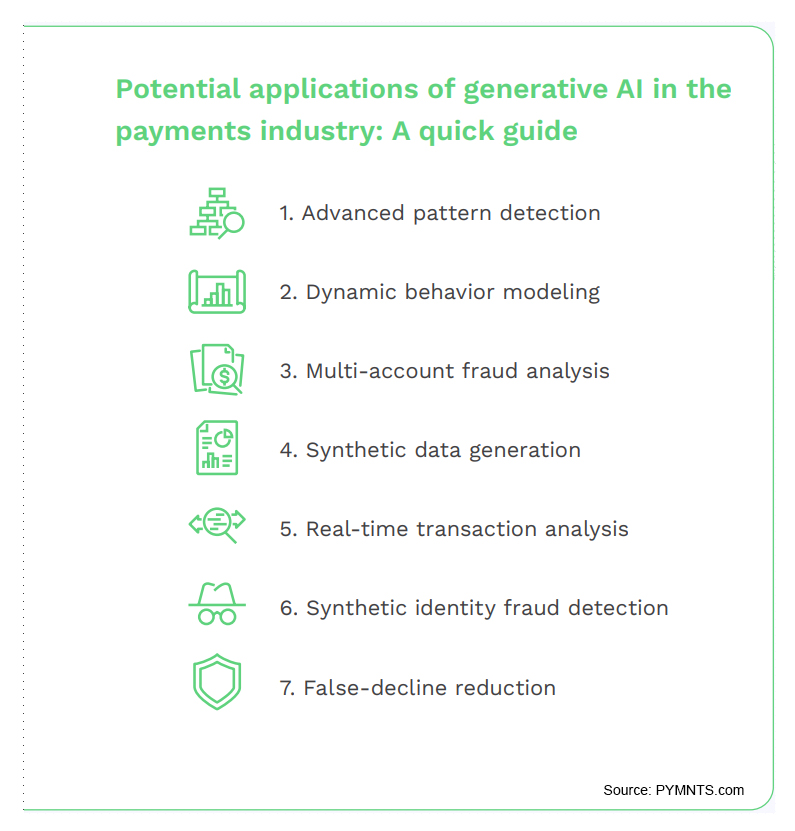
The landscape of payments fraud is undergoing a shift as traditional detection methods become increasingly inadequate against sophisticated fraud schemes.
Conventional rules-based systems, relying on static rules and predefined patterns, are falling short in adapting to the dynamic tactics of modern fraudsters.
Enter generative artificial intelligence, a technology that promises to redefine fraud detection by uncovering subtle and evolving fraud patterns with unprecedented accuracy. This new approach not only enhances detection but also addresses issues such as privacy concerns and the high incidence of false positives.
The PYMNTS Intelligence report “Can Generative Al Break the Payments Fraud Cycle?” provides an in-depth exploration of how generative AI is poised to revolutionize fraud detection and address the limitations of conventional systems.

Traditional fraud detection systems are increasingly inadequate in addressing sophisticated fraud schemes. These systems demand frequent manual updates and suffer from high false-positive rates, causing inconvenience for legitimate customers and taxing resources. Generative AI employs unsupervised learning to uncover complex fraud patterns and anomalies that conventional systems often miss.
Visa’s Visa Account Attack Intelligence Score uses generative AI to analyze transaction data in real time, achieving an 85% reduction in false positives compared to other models, for example. This advanced system enhances risk assessment for card-not-present transactions, improves decision-making for card issuers, and boosts consumer satisfaction while mitigating financial losses.
Generative AI offers a solution to the challenges of fraud detection models that rely on real-world financial data, which often raises privacy and compliance concerns. By generating synthetic datasets that replicate actual transactions without exposing sensitive information, generative AI ensures adherence to privacy regulations while enhancing the robustness of fraud detection systems.
Bunq, a European FinTech, demonstrates the efficacy of this approach, having integrated generative AI into its transaction-monitoring system. The innovation has boosted Bunq’s data processing efficiency by more than five times and accelerated fraud detection model training by nearly 100 times compared to previous methods. Using synthetic data, Bunq continues to refine its fraud detection algorithms while upholding privacy standards.
Generative AI is revolutionizing fraud detection by enhancing both speed and accuracy compared with traditional methods. Mastercard’s deployment of generative AI has improved its fraud detection capabilities, achieving a twofold increase in the speed of identifying compromised cards and a 300% boost in the identification speed of at-risk merchants. These advancements allow for quicker response times and diminish the opportunity for fraudulent activities, thereby fortifying the digital payments ecosystem.
Generative AI’s ability to learn from extensive datasets and adapt in real time to new fraud schemes offers a more agile and effective approach to fraud prevention. This adaptability is crucial for countering the evolving tactics of fraudsters and ensuring a secure payments environment.
Generative AI represents an advancement in combating payments fraud. By facilitating real-time adaptation, enhancing privacy through synthetic data, and improving both detection speed and accuracy, it can transform fraud prevention strategies.
As financial institutions and businesses adopt this technology, they have the potential to boost fraud detection capabilities and reduce operational inefficiencies. The ongoing evolution of generative AI is set to play a role in protecting the integrity of the payments ecosystem against sophisticated fraud tactics.